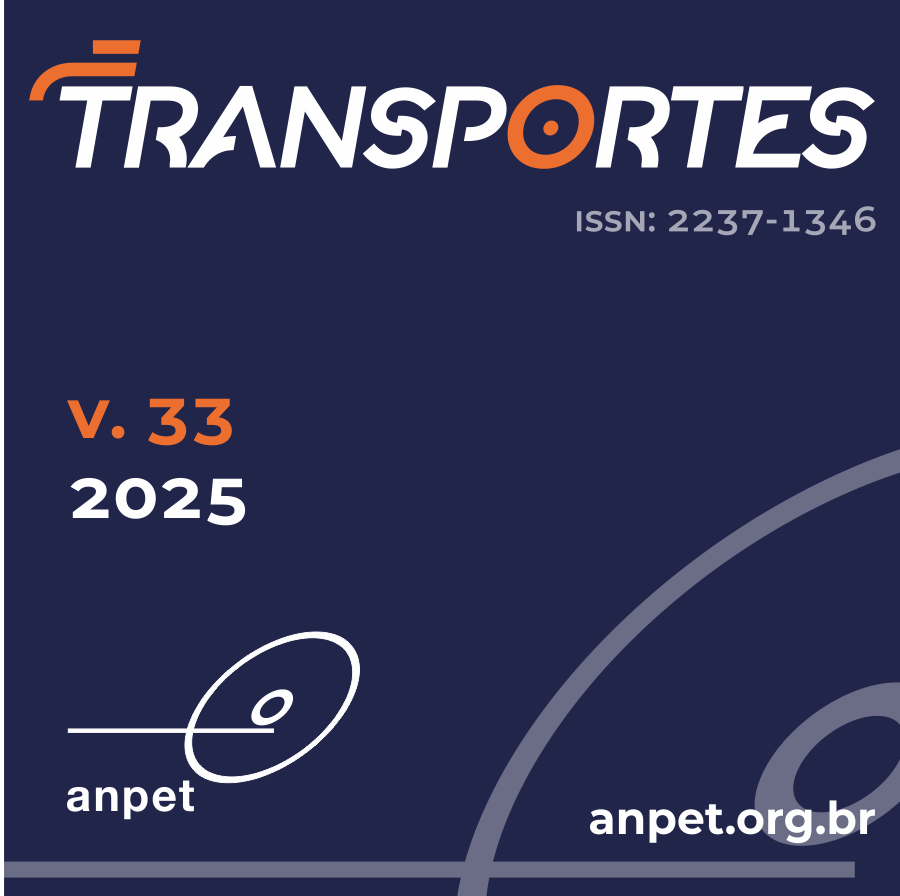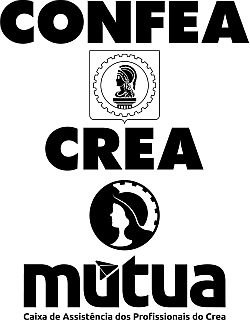3D FE analysis of urban asphalt pavements on public transport roads under a rolling bus tyre
DOI:
https://doi.org/10.58922/transportes.v33.e3111Keywords:
Dynamic analyses. Flexible pavements. Acceleration and braking. Longitudinal grade. Finite elements.Abstract
Understanding the structural mechanisms at which the asphaltic pavements are subjected in the field can prevent premature failure. In this work, dynamic and static 3D finite element analyses were performed and compared among themselves to evaluate their effects in terms of constant speed, acceleration, braking, roughness and longitudinal slopes of the roadway. Numerical analysis is a non-destructive research method which allows access to the response at any internal point of the pavement in a more economic and sustainable way. A common urban pavement section was chosen for the analyses as being representative of passenger transportation routes in Curitiba – Brazil. A standard bus was considered for the analyses and the parameters simulated diverse and usual traffic and service conditions. According to this analysis, acceleration in downward slopes represents the most critical situation for the pavement under study, reaching values up to 24 times greater than those in the static condition.
Downloads
References
Assogba, O.C.; Y. Tan; Z. Sun et al. (2021) Effect of vehicle speed and overload on dynamic response of semi-rigid base asphalt pavement. Road Materials and Pavement Design, v. 22, n. 3, p. 572-602. DOI: 10.1080/14680629.2019.1614970. DOI: https://doi.org/10.1080/14680629.2019.1614970
ASTM (2023) ASTM E 1960-98: Standard Practice for Calculating International Friction Index of a Pavement Surface. West Conshohocken, PA: ASTM
Brasil (1997) Lei nº 9.503. Institui o Código de Trânsito Brasileiro. Diário Oficial da República Federativa do Brasil. Brasília. Available at: <https://www.planalto.gov.br/ccivil_03/leis/l9503.htm> (accessed 03/27/2025).
Chen, B.; X.C. Wang and K. Mu (2011) Mechanical response of longitudinal slope segments based on Burgers Model. Advanced Materials Research, v. 243, n. 249, p. 4172-4177. DOI: 10.4028/www.scientific.net/AMR.243-249.4172. DOI: https://doi.org/10.4028/www.scientific.net/AMR.243-249.4172
CNT (2018) Conheça os 13 Principais Defeitos do Pavimento das Rodovias. Available at: <http://www.cnt.org.br/imprensa/noticia/conheca-principais-defeitos-pavimento> (accessed 03/27/2025).
DNIT (2006) Manual de Restauração de Pavimentos Asfálticos (3a ed., No. IPR-720). Rio de Janeiro: DNIT.
DNIT (2010) Manual de Projeto Geométrico de Travessias Urbanas (No. IPR-740). Rio de Janeiro: DNIT.
DNIT (2012) Quadro de Fabricantes de Veículos. Rio de Janeiro: DNIT. Available at: <https://www.gov.br/dnit/pt-br/rodovias/operacoes-rodoviarias/pesagem/QFV2012ABRIL.pdf> (accessed 03/27/2025).
DNIT (2013) Norma DNIT 005/2003-TER. Defeitos nos Pavimentos Flexíveis e Semi-Rígidos Terminologia. Rio de Janeiro: DNIT.
Farias, M.M. (1997) The influence of horizontal loads on the fatigue of pavements’. In Symposium on Recent Developments in Soil and Pavement Mechanics. Rio de Janeiro, pp. 359-365. Available at: <http://worldcat.org/isbn/9054108851> (accessed 03/27/2025).
Feng, L.; J. Liu; H. Wang et al. (2012) Shear stress of asphalt pavement in steep slope sections. In International Conference on Transportation Engineering 2009. ASCE, p. 869-874. DOI: 10.1061/41039(345)144. DOI: https://doi.org/10.1061/41039(345)144
Figur, N.E. (2019) Estudo das Tensões e Deflexões em Pavimentos Flexíveis Devido à Atuação de Cargas Dinâmicas dos Veículos: Uma Análise Numérica. Dissertação (mestrado). Universidade Federal do Paraná. Curitiba. Available at: <https://hdl.handle.net/1884/63115> (accessed 03/27/2025).
Ghoreishy, M.H.R. (2006) ‘Finite element analysis of the steel-belted radial tyre with tread pattern under contact load’. Iranian Polymer Journal, v. 15, n. 8, p. 667-674.
Giurgiu, T.; F. Ciortan and C. Pupaza (2013) Static and transiente analysis of radial tires using ANSYS. In Recent Advances in Industrial and Manufacturing Technologies: Proceedings of the 1st International Conference on Industrial and Manufacturing Technologies (INMAT’13). Athens, p. 148-152. Available at: <https://www.researchgate.net/publication/301560795_Static_and_Transient_Analysis_of_Radial_Tires_Using_ANSYS> (accessed 03/27/2025).
Hajj, E.Y.; P. Thushanthan; P.E. Sebaaly et al. (2012) Influence of tyre-pavement stress distribution, shape, and braking on performance predictions for asphalt pavement. Transportation Research Record: Journal of the Transportation Research Board, v. 2306, n. 1, p. 73-85. DOI: 10.3141/2306-09. DOI: https://doi.org/10.3141/2306-09
Hammoum, F.; A. Chabot; D. St-Laurent et al. (2010) Effects of accelerating and decelerating tramway loads on bituminous pavement. Materials and Structures, v. 43, n. 9, p. 1257-1269. DOI: 10.1617/s11527-009-9577-9. DOI: https://doi.org/10.1617/s11527-009-9577-9
Khavassefat, P.; D. Jelagin and B. Birgisson (2014) Dynamic response of flexible pavements at vehicle–road interaction. Road Materials and Pavement Design, v. 16, n. 2, p. 256-276. DOI: 10.1080/14680629.2014.990402. DOI: https://doi.org/10.1080/14680629.2014.990402
Kuo, C.M.; K.T. Hall and M.I. Darter (1995) Three-dimensional finite element model for analysis of concrete pavement support. Transportation Research Record: Journal of the Transportation Research Board, n. 1505, p. 119-127.
Li, C. and L. Li (2012) Criteria for controlling rutting of asphalt concrete materials in sloped pavement. Construction & Building Materials, v. 35, p. 330-339. DOI: 10.1016/j.conbuildmat.2012.04.003. DOI: https://doi.org/10.1016/j.conbuildmat.2012.04.003
Li, Y.C. and Y.Y. Xin (2014) The dynamic response of large longitudinal slope of asphalt road pavement under heavy impulsive load. Advanced Materials Research, v. 1065-1069, p. 806-813. DOI: 10.4028/www.scientific.net/AMR.1065-1069.806. DOI: https://doi.org/10.4028/www.scientific.net/AMR.1065-1069.806
Medina, J. and L.M.G. Motta (2015) Mecânica dos Pavimentos (3a ed.). Rio de Janeiro: Interciência.
Meyers, M.A. and K.K. Chawla (2009) Mechanical Behaviour of Materials (2nd ed.). Cambridge: Cambridge University Press.
Nonde, L. (2014) Effect of vertical and horizontal load on pavement interface shear stress. International Journal of Engineering Research & Technology, v. 3, n. 10, p. 1295-1299.
Saad, B.; H. Mitri and H. Poorooshasb (2005) Three-dimensional dynamic analysis of flexible conventional pavement foundation. Journal of Transportation Engineering, v. 131, n. 6, p. 460-469. DOI: 10.1061/(ASCE)0733-947X(2005)131:6(460). DOI: https://doi.org/10.1061/(ASCE)0733-947X(2005)131:6(460)
Saleh, M.F.; M.S. Mamlouk and E.B. Owusu-Antwi (2000) Mechanistic roughness model based on vehicle-pavement interaction. Transportation Research Record: Journal of the Transportation Research Board, v. 1699, n. 1, p. 114-120. DOI: 10.3141/1699-16. DOI: https://doi.org/10.3141/1699-16
Schmidt, E.P. and C.E.N.A. Mazzilli (2017) Influência da flexibilidade do tabuleiro na resposta dinâmica de pontes rodoviárias curvas. Revista IBRACON de Estruturas e Materiais, v. 10, n. 3, p. 706-743. DOI: 10.1590/s1983-41952017000300009. DOI: https://doi.org/10.1590/s1983-41952017000300009
Seco, R. (2016) Curitiba, ‘Cidade Modelo’, Busca Novas Referências: ‘Ao Menos Não Somos São Paulo’. Available at: <http://brasil.elpais.com/brasil/2016/06/30/politica/1467311191_496018.html> (accessed 03/27/2025)
URBS (2017a) Composição da Frota. Curitiba. Available at: <https://www.urbs.curitiba.pr.gov.br/transporte/rede-integrada- de-transporte/42> (accessed 03/27/2025).
URBS (2017b) Características da RIT. Curitiba. Available at: <https://www.urbs.curitiba.pr.gov.br/transporte/rede-integrada- de-transporte/18> (accessed 03/27/2025).
Yang, J.; W. Li; Z. Yu et al. (2010) Finite element analysis of asphalt pavement on long-steep longitudinal slope. Journal of Traffic and Transportation Engineering, v. 10, n. 6, p. 20-24. DOI: 10.19818/j.cnki.1671-1637.2010.06.004.
Yin, Y.; H. Wen; L. Sun et al. (2020) The influence of road geometry on vehicle rollover and skidding. International Journal of Environmental Research and Public Health, v. 17, n. 5, p. 1648. DOI: 10.3390/ijerph17051648. PMid:32138346. DOI: https://doi.org/10.3390/ijerph17051648
Youtube (2025a) Pavement Deflections, for i=0% 40Km/h (at Constant Speed, Intermediate Rough Surface). Available at: <https://youtu.be/p0ejW8zLGLo> (accessed 03/27/2025).
Youtube (2025b) Pavement Deflections, for i=+%11 40Km/h (at Constant Speed, Intermediate Rough Surface). Available at: <https://youtu.be/RHZu1SSu9oY> (accessed 03/27/2025).
Youtube (2025c) Pavement Deflections, for i=-11% 40Km/h (at Constant Speed, Intermediate Rough Surface). Available at: <https://youtu.be/37UFyhxDUhg> (accessed 03/27/2025).
Zaghloul, S. and T. White (1993) Use of a three-dimensional, dynamic finite element program for analysis of flexible pavement. Transportation Research Record: Journal of the Transportation Research Board, n. 1388, p. 60-69.
Zhang, N.M. and X.D. Wang (2010) Deformation analysis of pavement structures under coexistence of vertical and horizontal loads. Applied Mechanics and Materials, v. 44-47, p. 3053-3059. DOI: 10.4028/www.scientific.net/AMM.44-47.3053. DOI: https://doi.org/10.4028/www.scientific.net/AMM.44-47.3053
Zhang, H.; M. Yang and Y. Ma (2020) Study on the performance of high-modulus asphalt concrete pavement in extreme curves or steep slopes of trunk highway. Stavební Obzor - Civil Engineering Journal, v. 29, n. 1, p. 97-109. DOI: 10.14311/CEJ.2020.01.0009. DOI: https://doi.org/10.14311/CEJ.2020.01.0009
Downloads
Published
How to Cite
Issue
Section
License
Copyright (c) 2025 Neusa Eliana Figur, Daniane Franciesca Vicentini

This work is licensed under a Creative Commons Attribution 4.0 International License.
Authors who submit papers for publication by TRANSPORTES agree to the following terms:
- The authors retain the copyright and grant Transportes the right of first publication of the manuscript, without any financial charge, and waive any other remuneration for its publication by ANPET.
- Upon publication by Transportes, the manuscript is automatically licensed under the Creative Commons License CC BY 4.0 license. This license permits the work to be shared with proper attribution to the authors and its original publication in this journal.
- Authors are authorized to enter into additional separate contracts for the non-exclusive distribution of the version of the manuscript published in this journal (e.g., publishing in an institutional repository or as a book chapter), with recognition of the initial publication in this journal, provided that such a contract does not imply an endorsement of the content of the manuscript or the new medium by ANPET.
- Authors are permitted and encouraged to publish and distribute their work online (e.g., in institutional repositories or on their personal websites) after the editorial process is complete. As Transportes provides open access to all published issues, authors are encouraged to use links to the DOI of their article in these cases.
- Authors confirm they have obtained all required employer permissions for the publication and CC BY 4.0 licensing of the manuscript, particularly if the employer holds any claim to the manuscript's copyright. Authors assume all responsibility for employer-related copyright issues, releasing ANPET and Transportes from any related liability.
- Authors assume full responsibility for the content of the manuscript, including the necessary and appropriate authorizations for the disclosure of collected data and obtained results, releasing ANPET and Transportes from any responsibility in this regard.
Last update: 11/27/2025











